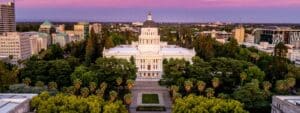Posted by Lauren Sommer
This won’t come as a surprise to Bay Area residents: the region is still growing. By one estimate, the Bay Area will add two million people by 2040, a 30 percent increase over today’s population of about seven million.
More people means more housing and more traffic. But regional planning agencies have another target to contend with: by 2040, the Bay Area must cut its greenhouse gas emission by 15 percent. It’s part of SB 375, a state law requiring local communities to help meet California’s climate change goals through land use and transit planning.
The Bay Area’s effort is being coordinated with Plan Bay Area, a region wide development plan being put together by the Association of Bay Area Governments (ABAG) and the Metropolitan Transportation Commission (MTC).
“We have had a pattern in the past of extending our development and urban frontiers into our open space and green space,” says Miriam Chion, Planning and Research Director at ABAG. “And that resulted in a lot more driving.”
Chion says the key to cutting greenhouse gas emissions is giving residents more options for public transit or walking. Plan Bay Area identifies “Priority Development Areas,” where 80 percent of new housing and 60 percent of new jobs would be located in walkable neighborhoods that are close to transit and series.
This continues an existing trend, says Chion. “Many of our knowledge-base workers and businesses are choosing urban settings over traditional office park locations,” she says.
The plan also seeks to minimize sprawl by keeping future growth within existing urban boundaries. “That’s a huge statement,” says Stephanie Reyes of Greenbelt Alliance. “No other region comes even close to achieving that level of in-fill development and open space protection.”
Meeting these goals will be up to cities and counties, however. “There’s good news and bad news,” says Reyes. “Here in the Bay Area, many communities, though not all, are supportive of protecting our iconic landscapes and open spaces and are generally looking to build inward instead of outward.
“That said, some communities are more willing and enthusiastic than others to actually do that work of planning for and building homes for folks at all income levels,” Reyes says.
Cities and counties rely on their own general plans to guide development. “What changes might be made over the next 10, 20, 30 years, that is going to be decided locally,” says Linda Jackson, planning manager Transportation Authority of Marin.
The planning process has raised concerns from some communities over how much growth is included in the plan. “To the extent that Plan Bay Area in their projections for 2040 is higher than what a general plan or a town is currently planning for, there is some concern and awareness of having to discuss that kind of increased growth for their community,” says Jackson.
Local jurisdictions that adopt the plan’s goals will receive prioritized funding through the One Bay Area grant program. It provides $14 billion over the next several decades for transportation projects.
Still, supporters of the plan say it’s brought about much-needed conversations about the Bay Area’s future growth. “While the law is not full of lots of sticks and punishments, it has really had an enormous effect on the dialogue and conversation about growth in the region,” Reyes.
A public comment period on the plan is open until May 16th. Marin, San Mateo, Santa Clara and Alameda Counties are holding public meetings this week.
Areas of Priority Development in Plan Bay Area:




